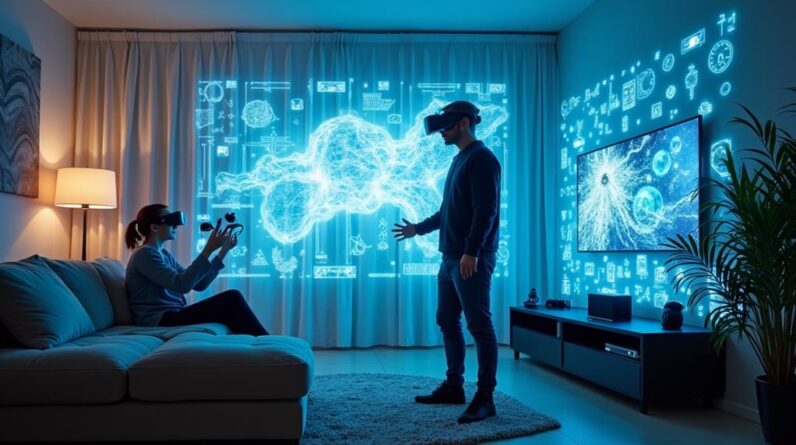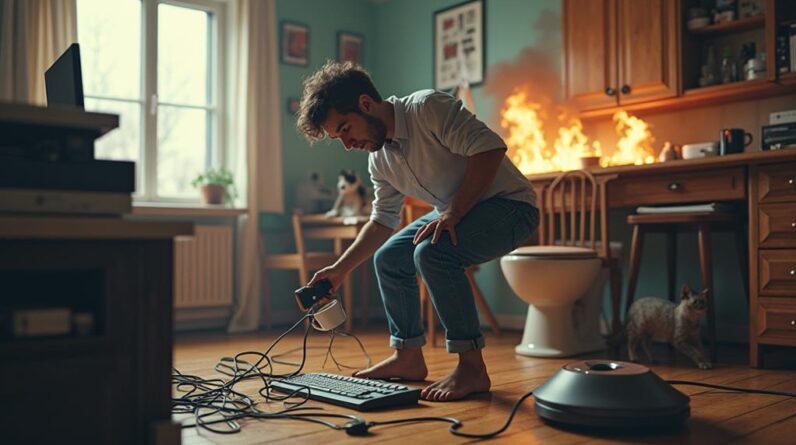
This episode is brought to you by Simplisafe. Right now they’re having their best sale
of the year, but more on that later! Smart homes offer so much potential for security,
energy savings, and convenience, but why … why do they have to be so complicated? Let's take a look at my smart home, which
I love and have been refining for 10 years, to see why so many people think smart homes
are just stupid homes. And what's coming in the future that may fix
all of it. I'm Matt Ferrell … welcome to Undecided. If you've seen any of my previous smart home
videos, you know that I love this technology, but in all of the feedback I get there's a
clear trend. This stuff is just way too complicated for
the general public out there. People are interested, but are struggling
to understand where to start … and even when they do start …
They can quickly get
overwhelmed. If you've been trying to setup a smart home
and it's not as easy as it looks like it should be, there's a reason for that. Let me take you through my smart home as an
example of why they're awesome … and also frustrating. I've been refining my smart home for over
ten years and ended up with what I have now by sliding down that slippery slope of smart
home automations. It all started with a few Philips Hue light
bulbs a long time ago and ended up … here. Let's start at the top. This is my Hubitat Elevation Hub that I use
as the central brain of my home automation cobweb of insanity.
I did a review of this a little over a year
ago and talked about why I switched from Smartthings to this little guy. My original opinions of Hubitat still hold
true today. It's a very capable little hub that supports
all of the major standards that are out there like WiFi, Zigbee, and Z-Wave. It has integrations into IFTTT, Amazon and
Google, so it's super easy to get those voice assistants controlling everything with a simple
command. Everything is privacy-focused and in your
control. But my biggest gripe with it hasn't changed:
the user interface is a hot mess … it's not good … and this is coming from someone
who's worked as a user interface and experience designer for over 20 years. The pros of this are that it's easy to setup. Taking it out of the box and getting it up
and running and hooking up your initial devices is pretty easy. Far easier than a lot of other self hosted
options out there, but once you get into the deeper home automation controls with the feature
they call Rule Machine … it's awful. No other way to say it.
I hate it. The longer I've used it … the deeper my
hatred for Rule Machine becomes. Thankfully you don't have to use it on a daily
basis. Once you get automations set up, it's a set-it-and-forget-it
type of thing. And the stability of the system has been perfect
for me. My Smartthings setup up was constantly having
services go offline, which made the whole thing frustrating to use. The Hubitat … never had that happen once,
but I've had issues with weak Zigbee and Z-Wave signal strength. That was never an issue with Smartthings. I had to buy some repeaters and put them around
my house to strengthen that signal, which did the trick. Would I still recommend Hubitat? Yes, but only if you're someone who isn't
afraid to tinker and has some comfort level with scripting and computers.
It's not a device I'd recommend to the average
Joe off the street … it's not meant for the mass market with the user experience it
has today. So if I hate the interface so much, why am
I still using it? Before I get to though, I'd like to thank
Simplisafe for sponsoring this video. Unlike what I was just talking about, Simplisafe
definitely has a user experience meant for the mass market. When it comes to home security, you want something
that's easy to setup, has all of the hardware you need, and offers 24/7 professional monitoring. I've had issues in the past with flakey sensors
or the fact that my self hosted systems didn't have a team of people helping to monitor it.
I work from home, so it's not only my personal
belongings I want to protect, but my business. Setting up SimpliSafe couldn't have been easier
and took, no joke … probably about 15 minutes for basics. The door and motion sensors are really responsive
and knowing that the monitoring center will call the police if they're alerted to an issue
really gives me peace of mind. There’s almost always a rise in break-ins
during the holidays. That’s why SimpliSafe is having their best
sale of the year right now. Visit simplisafe.com/undecided to get 30%
off your system plus a free camera. Thanks to SimpliSafe and to all of you for
supporting the channel. So back to why I'm sticking with Hubitat as
the central brain for the rest of my smart home when I really don't like the interface
…
Well, it's the best option for my situation
when you look at the landscape of what's out there and available in the US. Smartthings has a decent user experience and
is easier for novice users to setup and get going, but the more you build out your system
you'll start to run into the same stability problems that I did. But if you're trying to keep things simple,
Amazon and Google are great entry points into smart homes. However, they're massive walled gardens. The more you build out your smart home within
those walls, the harder it is to get out when you start bumping into the limitations. Apple Homekit is very accessible and works
really well from my experience, but is also a walled garden that limits your options … there's
fewer Homekit enabled devices out there than there are for everything else. But it's the best privacy first option we
have from a major platform provider. Check out [Shane Whatley's YouTube channel](https://www.youtube.com/channel/UCVYd9HVKN-LeYNM_wc1P2HA)
if you're interested in a Homekit focused smart home.
He's got some great how-tos and reviews. There's also other self-hosted smart home
software like Home Assistant, but it's even more unfriendly to novices than Hubitat. Home Assistant can do anything you want, but
good luck getting up to speed if you don't know scripting or computer programming. Not everyone wants to tinker with this stuff. Home Assistant is like Linux vs. Windows or
Mac. How many people out there want to use Linux
as their main computer at home? To give myself flexibility I've got a crazy
number of hubs Macgyvered into my Hubitat. There's my Philips Hue hub acting as a bridge
for 24 Hue devices. There's a Lutron Caseta Pro hub bridging 17
Lutron devices. Logitech Harmony Hubs for each TV setup in
the house (that's three in total). A Raspberry Pi running Homebridge to make
all of the non-Homekit devices accessible to Apple Homekit and the Home app. A Eufy hub for most of the Eufycams around
the house, but sadly that doesn't tie into any of my other systems …
With the exception
of Homekit for a few of the cameras. And at one point I had a Keen smart vent hub
for controlling my smart vents. I've ditched that hub and linked the Keen
smart vents directly into the Hubitat hub, but how should I put this … I hate these
Keen smart vents. They chew through batteries unlike anything
else I've used. So with all of that hub craziness I've been
able to link the vast majority of the things in my home together into one cohesive smart
home.
It's that easy. Hubitat is acting as the brain, which is where
I setup all of the automations for things that happen automatically without direct user
interaction. Things like when the house is empty making
sure all of the doors are locked, the garage door is down, the lights are off, intrusion
detection is turned on, and the HVAC is set to an away mode. Or turning on the exterior lights when someone
arrives home after dark. And a more recent addition that I really love
is auto-locking the exterior doors after they've been shut for a couple of minutes.

I can't tell you how many times one of us
has come in and forgotten to do that. It's been working great and all locally and
in my control, so privacy is a key feature there. No cloud services to muck things up or cause
delays. While the setup is a little complicated it's
given me the freedom to move between major smart home services. I can use Amazon, Apple, or Google voice assistants
with this setup for one-off verbal commands if I want. For me I've been using Google the past year
or so, but may be switching over to Apple soon.
It's really no fuss to jump between them. A good example of why I like this type of
setup is with the app I use on my phone for direct control if I need it. Hubitat's mobile app is really just a window
into a web view for controls. So you're essentially seeing a webpage in
an iPhone app wrapper. This makes it easier for the developers to
code once and have it work everywhere, but it makes for a weaker user experience. The app is sluggish and sometimes takes a
few seconds for the screen to fully load and display. Apple's Home app is a much nicer UI and ties
into Siri for additional voice control and shortcuts, so my Raspberry Pi running Homebridge
has been super useful there.
I won't walk through how to setup Homebridge,
but there are some good instructions written up on the website. And there are third party options like [Hoobs](https://hoobs.org),
that take the frustration out of setting something like this up. It's more plug and play. My Homebridge setup is really set it and forget
it. I've never had it crash. It doesn't need any tweaking after the initial
setup … it's great. In Hubitat you use the Maker API functionality
to control which devices will be surfaced to Homebridge, so if you add a new device
you just go into the Maker settings, add it to the list, and it will just show up in the
Home app.
It's a similar experience if you want to reveal
devices to Google. In Hubitat's Google Home app, you just select
the devices you want to surface and in the Google Home app they'll show up. It's this level of control and ability to
wall things off for privacy, but at the same time surface specific things for broader integrations,
that makes Hubitat so powerful. But the geolocation functionality for Hubitat
has proven to be unreliable. To solve that I installed a community created
Hubitat app for geolocation called the Presence Governor. It uses multiple services to try and determine
if you're home or not. In my case I'm layering Life360's geolocation,
and iPhone showing up on my WiFi as additional markers for if I'm home or not. After setting this up the geolocation for
my Hubitat system has been fantastic.
And because I have things setup the way I
do, I can buy pretty much any smart home device I want and get it tied into my broader system. That's not true across the board though with
things like my Eufy products … they're on an island by themselves because Eufy hasn't
made integrations possible yet universally. A handful of my cameras are on Homekit, but
even with that limitation I still love my Eufy cameras. So if I've done so much with my smart home,
why am I bagging on smart homes a bit in this video? Well, because the user experience sucks. I've heard from so many of you asking where
to start.
It's a tough question because it depends on
what type of person you are. Are you a DIYer? A tinkerer? A developer? Or a complete newbie with limited computer
experience? Depending on where you fall into those buckets
changes the answer dramatically. Just look at the examples I gave from my smart
home setup. It's very flexible and I have a ton of options,
but it's very fiddly. There's a lot of customization and hoops I
had to jump through to get it working in a way that fit my needs. On one hand that flexibility is amazing, but
on the other it's horrible for a novice. There's a reason why Amazon has taken such
a commanding lead on the voice assistant and smart home front.
They've done an incredible job making smart
homes accessible and relatively easy to set up. The cheapest and easiest solution will win
every day of the week, which is why I find this so frustrating. Because Amazon's ecosystem isn't the best
option out there, but it's the easiest one right now. Even worse are the crazy number of knockoff
devices out there that are WiFi connected. Some use their own proprietary systems, while
others are built on top of broader platforms like Tuya. All of these will end up flooding your WiFi
router if you add too many devices, and remember that each WiFi connected device is adding
another vector and intrusion point into your digital home. How securely were those devices made? Do they get regular firmware updates to plug
security holes? Where are they sending data to? From a privacy perspective, WiFi devices really
give me pause. I do have a bunch, but I'm pretty selective
based on who makes them and how much control I can get over them.
Go in with your eyes open. Thankfully there is a light at the end of
the tunnel here. A shining beacon of hope for smart homes and
mass market adoption. All of the major players, which includes Apple,
Google, Amazon, Zigbee, Z-Wave, Tuya, etc., have signed on to Project CHIP (Connected
Home Over IP). The whole goal of this is to build a standard
for all smart home devices. It will ensure that CHIP-certified devices
will be able to talk directly with each other. The crazy patchwork I've built out for myself
may slowly become unnecessary if CHIP devices are as interoperable as promised. The open standard is supposed to launch sometime
this year, but I don't think we'll start seeing CHIP-certified devices hitting the market
for a year or two. It's probably going to have a bigger impact
on the smart home market in 3-5 years, so we're going to have to ride out the smart
home wild west for a bit longer. Do I still advocate for getting started with
a smart home? Yes. Just go in with your eyes open and know that
you're going to run into some stumbling blocks along the way.
Try to build out a system that's using cross-platform
capable devices where you can to give yourself options down the road. And hopefully, CHIP will help smooth out the
user experience rough edges that exist today. Until that point, I don't think most people
will want to go beyond dipping their toe into the smart home pool with a few devices. So what do you think? Jump into the comments and let me know what
systems you use … or if you avoid smart home products because of these issues. And as always a special thank you to all of
my Patrons. All of your support is really helping to make
this possible. If you liked this video be sure to check out
one of the ones I have linked right here.
Be sure to subscribe if you think I’ve earned
it. And as always, thanks so much for watching,
I’ll see you in the next one..
As an Amazon Associate I earn from qualifying purchases.







